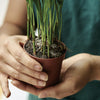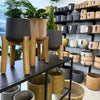More tips and tricks for growing houseplants
In this article, we would like to introduce you to a few tips and tricks for easier and better care of houseplants.
However, we must remember that plants have different needs, there are several types of soil, and the environments in which we have houseplants are also different. However, I sincerely hope that some tips and tricks from this article will help you and growing indoor plants will become your (even greater) love and pleasant hobby.

1. Stop watering houseplants according to the calendar
Watering "once in a while..." has become a deep-rooted myth. We should not plan to water the flowers. We must be guided primarily by the moisture of the soil in which we have our maid. If it is still wet a week after watering, wait a little longer before watering to avoid overflow and the subsequent death of the plant. Water for watering must be still and at room temperature.

You know when you water a flower and the water takes forever to soak in? The reason is probably too compacted soil or too dry substrate. Without transplanting, we can loosen the soil most quickly with, for example, Chinese chopsticks. Using wooden sticks, dig a few holes (carefully for the roots!) so that the water reaches the plant faster, the soil is more oxygenated and it absorbs the liquid better.
3. Recycled dressing
We're probably all familiar with waste recycling, but have you heard of water recycling? We can reuse the water from cooking - preferably the liquid used during the heat treatment of vegetables, pasta, rice or eggs. In this way, we supply the plant with a lot of nutrients and vitamins. But be careful, we must not use salted water , because it is toxic for roommates, at the same time we have to wait for it to cool down to room temperature.

4. Use of household waste
Do you throw away banana peels? You can reuse them as an important source of potassium for plants. Just throw the skins of this exotic fruit into a mason jar and let it stand for two days. Water the flowers with the liquid once a month.
In the same way, you can use the remains of coffee grounds. It supplies plants with the necessary acids. The best way is to add logr to the compost and then sprinkle it on the plants in the form of a substrate full of nutrients. Currently, so-called vermicomposters are very popular. These are containers intended for home composting of biowaste from the kitchen using earthworms. These are also suitable for living spaces, so everyone can make their own high-quality fertilizer in the comfort of their own home.

5. Increase in room humidity
The humidity in our room is reduced, for example, by radiators, which are a matter of course in winter, but many apartments also have low humidity. We can increase it in several ways - the first, and probably the easiest, is to move the plants closer to each other in one place. The water evaporates through the leaves of the plants, so by bringing them together, a microclimate with higher humidity is created.
If we would like to invest, we can purchase an air humidifier, which will be beneficial both for the plants and for our breathing throughout the year. Another option is to place bowls of water on the radiators in the winter. The water will gradually evaporate and increase the room humidity.

6. Regular dusting
The leaves of indoor plants are not only beautiful, but above all important for the life and main activity of the plant - photosynthesis. In order for a plant to properly absorb carbon dioxide and generate energy from it with the help of water and sunlight, its leaves must be clean and not hidden under a layer of dust.
We can wipe the leaves with a moistened cloth (preferably with soft rainwater) or a moistened napkin. If the green parts of the plant are oily, we can also use water with a drop of preferably BIO soap.

7. Uniform plant growth
Undoubtedly, we place houseplants in places where there is enough light, otherwise they would not grow properly and could even die. However, it can happen that leaves or flowers start to grow more towards a window or other light source (this phenomenon is called phototropism). That is why it is important to rotate the plants regularly, preferably after a week, but we must not change their position, so that the orientation to the side of the world does not change. Attention, we must not turn orchids with newly growing spikes.

8. Get out over the summer!
Air flow, fresh rainwater, light and a pleasant temperature. Maids can experience all this outside in the summer and believe me, it can be very beneficial for them after the winter season. However, we have to help the plants acclimatize a little to prevent them from being shocked. At the beginning, we place them in the shade, for example on the terrace or under a tree, gradually in a place with more incident light, and after a few weeks we can allow the plant full sunlight (not through direct midday sun).
We pay increased attention to watering, which we will probably have to do more often. If it is too hot outside, strong wind or we observe pests, we return the plants back inside.
9. I'm going on vacation, who will water the flowers?
A question that almost every owner of plants, not just indoor plants, has asked themselves at some point before going on vacation. The easiest solution to this problem is to place our room in a shadier place. It will automatically start using less water.
Another tip, especially for small plants, is a temporary greenhouse. We create it by sticking about four bamboo sticks (length about 5-10 cm above the plant) into the flower pot. Place a larger transparent plastic bag over the sticks so that it does not touch the plant, and secure it with a rubber band over the flower pot. We will place this small greenhouse out of direct sunlight so that our room does not boil.
For larger plants, we can cover the soil with moistened newspapers or paper towels. These must not touch the trunk or stems.

10. Plant society
Joining the "plant society", we could honestly say the association of houseplant lovers and growers, can have many positives. There are countless such associations - groups on social networks (Facebook, Pinterest), specialized websites or blogs, such as ours . :)
On all these platforms we can find different advice, ideas or even new friends with the same interests.
So which of these tips and tricks will you try?
Kristýna Kratochvilová




